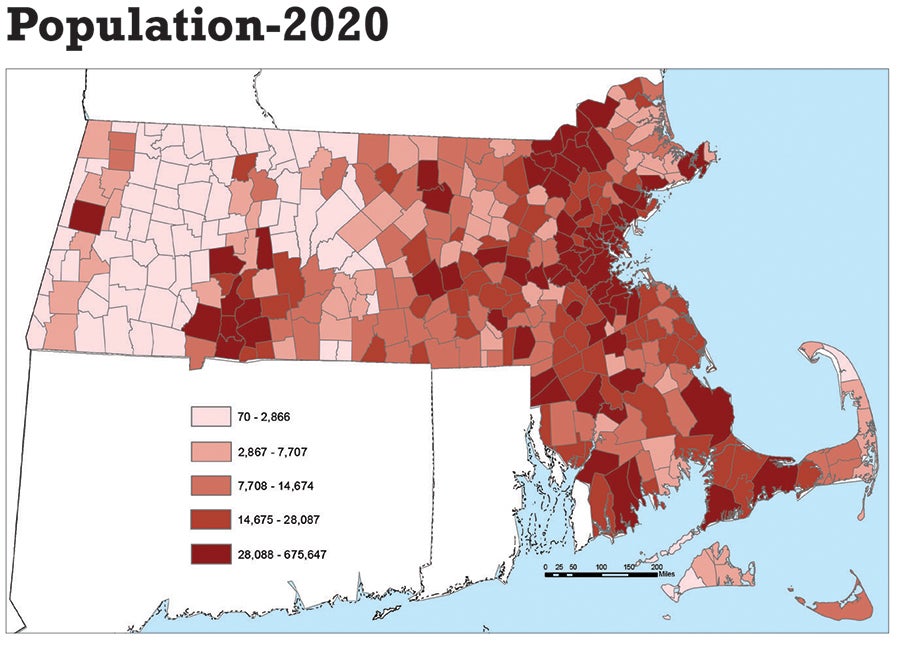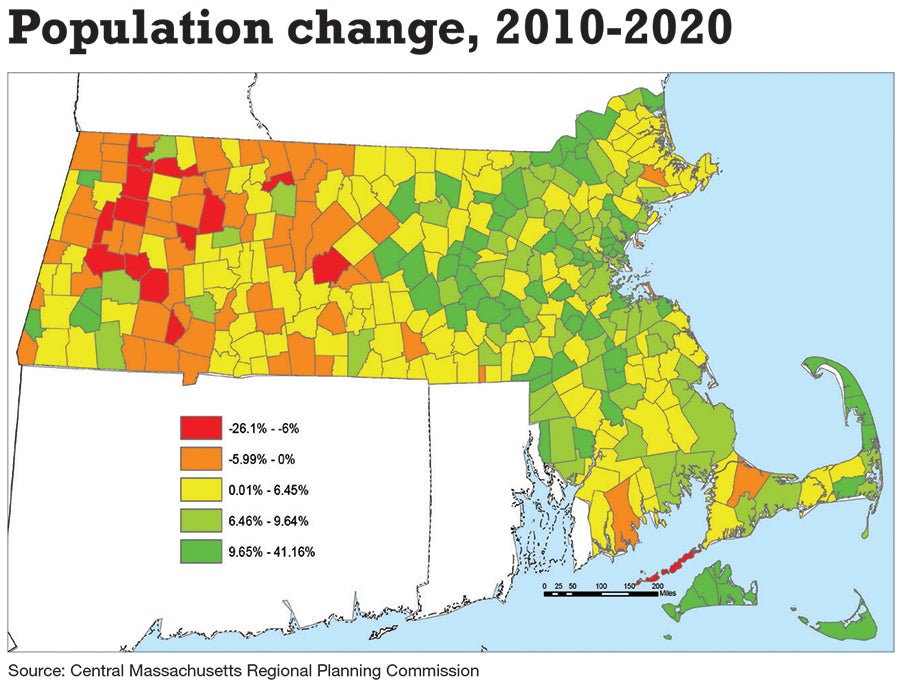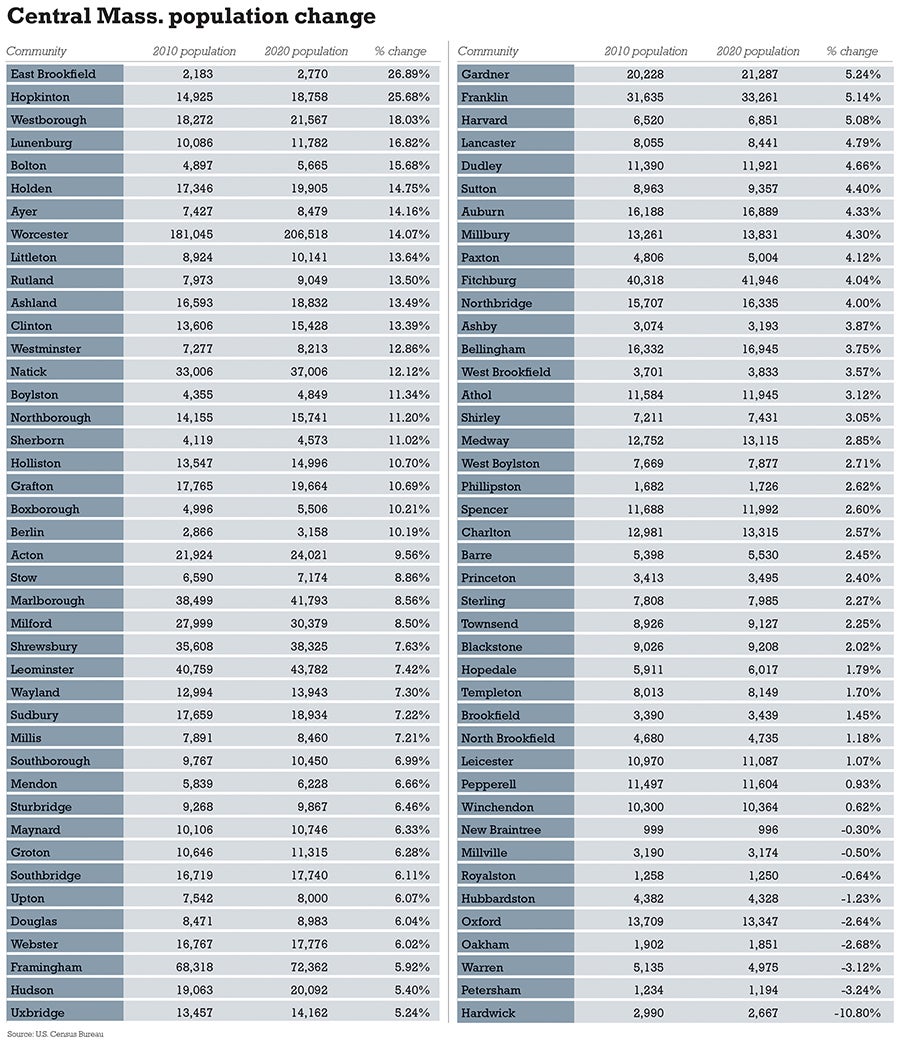Fueled by communities near I-495 and the Massachusetts Turnpike, the Central Massachusetts region grew 8.1% in population from 2010 to 2020, outpacing both the state (6.0%) and nation (6.5%), according to the U.S. Census Bureau’s Decennial Census of Population and Housing.
Get Instant Access to This Article
Subscribe to Worcester Business Journal and get immediate access to all of our subscriber-only content and much more.
- Critical Central Massachusetts business news updated daily.
- Immediate access to all subscriber-only content on our website.
- Bi-weekly print or digital editions of our award-winning publication.
- Special bonus issues like the WBJ Book of Lists.
- Exclusive ticket prize draws for our in-person events.
Click here to purchase a paywall bypass link for this article.
Fueled by communities near I-495 and the Massachusetts Turnpike, the Central Massachusetts region grew 8.1% in population from 2010 to 2020, outpacing both the state (6.0%) and nation (6.5%), according to the U.S. Census Bureau’s Decennial Census of Population and Housing.

The 84 cities and towns in Worcester County and MetroWest comprising the Central Massachusetts region now have an official population of 1,298,149, according to the 2020 Census, up from 1,201,125 in the last Decennial Census in 2010. Unlike the annual population updates from the Census Bureau and other sources like the UMass Donahue Institute, which rely on projections, the Decennial Census is a full accounting of people in each community, and the impact of this data lasts a lifetime as federal funds, school systems, political districts, and more are all determined by this information.
While communities like Hopkinton and Worcester saw substantial and fast-paced growth, rural towns like Hardwick experienced deep declines due to aging populations and distance from main transportation routes. The Census revealed a decrease in rural populations with the 10 greatest decreases in Central Massachusetts taking place in Hardwick, Petersham, Warren, Oakham, Oxford, Hubbardston, Royalston, Millville, and New Braintree.


“Our region outgrew initial projection by 3%,” said Robert Raymond, transportation planner for the Central Massachusetts Regional Planning Commission, one of 13 planning councils across the state and focused on transportation and land use planning to create strategic plans fostering growth in the city of Worcester and its 39 surrounding towns.
Accessibility to Boston through major transportation arteries like I-495 and I-290 along with reasonable proximity to commuter rails were important factors that people considered when moving, said Trish Settles, deputy director regional collaboration and community planning of CMRPC. The further away from transportation towns were, the less likely they were to experience population growth.
The town of Rutland saw a 13.5% population increase, which Settles attributes to its land availability, central location, and the fact the town is more affordable compared to cities like Marlborough.
“Rutland is surging in new housing development,” Settles said.
Striking the right balance
Hopkinton appears to be the big Central Massachusetts winner of the Decennial Census. Its population grew 26% over the past decade to 18,758, making it one of two communities to achieve more than a 25% growth rate in the region and the only one with more than 3,000 residents.
The town’s location near 495, the Mass Pike, and the commuter rails made it a strategic option for working professionals while young families were attracted to Hopkinton’s high-ranking public school system, said Hopkinton Town Clerk Connor Degan. Not only was the town able to attract younger generations, but older generations remained in town even as they aged by either downsizing to homes in other parts of town or by moving into the recently developed age-restricted housing community.
“We see the balance there struck between the aging population and population with school-age children,” Degan said.

Based in the eastern part of town, the Legacy Farms housing development has had a massive impact on the town’s expansion, Degan said, as it is expected to add more than 1,000 homes to Hopkinton by the time it is complete. The increased housing availability in a town already desirable because of its proximity to Boston, further motivated population growth.
Hopkinton is becoming a hotspot for tech companies, particularly biotech firms, looking for a more affordable option compared to Boston, Degan said, and is now home to businesses like LakePharma and Lykan Bioscience, in addition to being the long-time home of Dell Technologies after it acquired EMC Corp. in 2016. These firms draw in professionals from other areas who settle into Hopkinton.
Degan said if every piece of buildable land in Hopkinton was developed, the town could achieve a future population of 20,000 to 22,000 residents.
“The fact we are seeing new money and new growth shows that we are growing our tax base,” Degan said about the benefits of population growth.
Fastest-growing major New England city
Worcester saw a 14% increase in its population, going from 181,045 in 2010 to 206,518 in 2020, making Worcester the fastest growing of the 10 largest cities in New England.
Mixed-use buildings and a revamping of village-entered strategic plans helped cities and towns to encourage growth, according to the CMRPC. This is exemplified by the Worcester buildings on Front Street across from the Union Station, in which the bottom spaces are used for retail or office space to encourage workforce development while the upper floors are used for housing. Meanwhile, a village model is when a town facilitates most of its resources in the town center to encourage accessibility.
“Worcester has done some really cool things,” Settles said about Worcester’s strategic plans.
The city implemented strategies such as growing available housing stock and focusing on public and private investments to elevate the quality of life for residents, said Peter Dunn Worcester’s chief development officer.
In addition to increasing available housing, the city’s commercial investments led to job creation, which encouraged people to move into the city, Dunn said. He also cited small business startups, which added to the city’s amenities, diverse entertainment options, and investments in public assets like the public schools, public parks, and the public library.
“As we grow, we have been looking to add new tools to our toolbox to maintain affordability, such as the launch of the city’s first Affordable Housing Trust Fund, among other strategies,” Dunn said in a written statement.

Maintaining the charm
When looking at the Central Massachusetts towns with the largest population decreases, the rural town of Hardwick took the lead with an almost 11% drop. The town’s population went from 2,990 in 2010 to 2,667 in 2020.
An aging population combined with lack of industry/work opportunities for younger generations are obstacles the town is trying to overcome by focusing on destination small businesses like the town’s brewery, winery, and now a proposed cannabis cultivation, distribution, and retail center which would encourage job opportunities.
Hardwick Town Administrator Nicole Parker said the town is away from main routes, but those who move into town are looking for a quieter community and natural landscape. She said remote working is encouraging people in busy metropolitan areas to move into town, but these numbers will not be reflected until the next Decennial Census.
Since federal funds are allocated by population, Parker said the Census system creates a vicious cycle for rural towns, since they need infrastructure repairs and public resources to encourage people to move into town, yet these funds are directed to bigger towns and cities already with established populations.
Hardwick is changing bylaws and rezoning statutes in order to encourage small business development. However, Hardwick is trying to strike a delicate balance between creating a financially sustainable community with the growth of a younger population while ensuring its charm remains intact.
“We’re supposed to be small. We’re not supposed to be a town of 10,000. That is not the character of our town,” Parker said.


